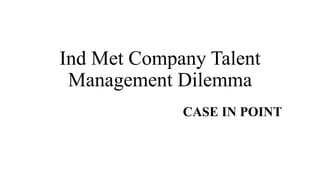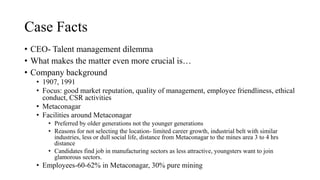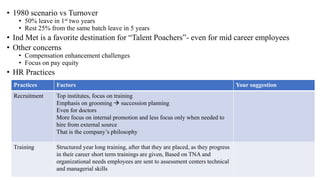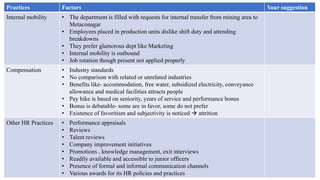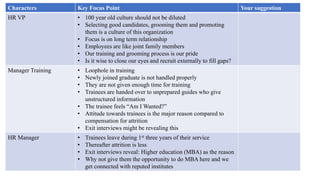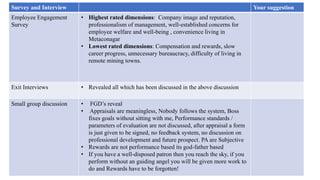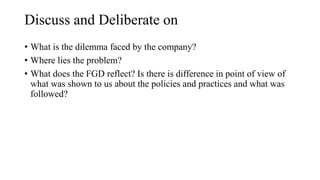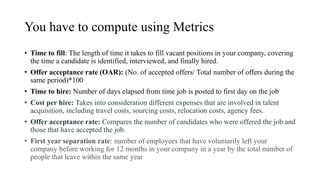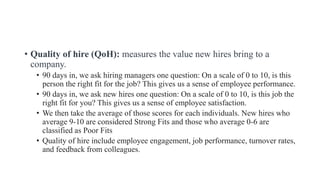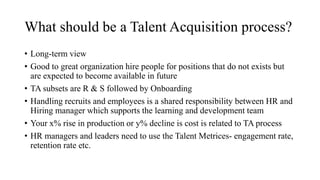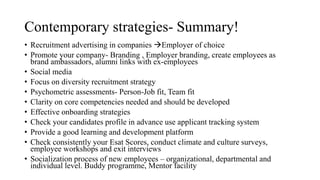Ind Met Company Talent Management Dilemma.pptx
- 1. Ind Met Company Talent Management Dilemma CASE IN POINT
- 2. Case Facts • CEO- Talent management dilemma • What makes the matter even more crucial is… • Company background • 1907, 1991 • Focus: good market reputation, quality of management, employee friendliness, ethical conduct, CSR activities • Metaconagar • Facilities around Metaconagar • Preferred by older generations not the younger generations • Reasons for not selecting the location- limited career growth, industrial belt with similar industries, less or dull social life, distance from Metaconagar to the mines area 3 to 4 hrs distance • Candidates find job in manufacturing sectors as less attractive, youngsters want to join glamorous sectors. • Employees-60-62% in Metaconagar, 30% pure mining
- 3. • 1980 scenario vs Turnover • 50% leave in 1st two years • Rest 25% from the same batch leave in 5 years • Ind Met is a favorite destination for “Talent Poachers”- even for mid career employees • Other concerns • Compensation enhancement challenges • Focus on pay equity • HR Practices Practices Factors Your suggestion Recruitment Top institutes, focus on training Emphasis on grooming succession planning Even for doctors More focus on internal promotion and less focus only when needed to hire from external source That is the company’s philosophy Training Structured year long training, after that they are placed, as they progress in their career short term trainings are given, Based on TNA and organizational needs employees are sent to assessment centers technical and managerial skills
- 4. Practices Factors Your suggestion Internal mobility • The department is filled with requests for internal transfer from mining area to Metaconagar • Employees placed in production units dislike shift duty and attending breakdowns • They prefer glamorous dept like Marketing • Internal mobility is outbound • Job rotation though present not applied properly Compensation • Industry standards • No comparison with related or unrelated industries • Benefits like- accommodation, free water, subsidized electricity, conveyance allowance and medical facilities attracts people • Pay hike is based on seniority, years of service and performance bonus • Bonus is debatable- some are in favor, some do not prefer • Existence of favoritism and subjectivity is noticed attrition Other HR Practices • Performance appraisals • Reviews • Talent reviews • Company improvement initiatives • Promotions , knowledge management, exit interviews • Readily available and accessible to junior officers • Presence of formal and informal communication channels • Various awards for its HR policies and practices
- 5. Round Table Discussion- And you decision! Characters Key Focus Point Your suggestion VP Manufacturing • Data- Attrition %-3.52, 4.23,3.22 • Time to fill • Proactive and aggressive strategy • Compensation package • Should not focus only on trainee executives with issue pertaining to attrition • We are favorite hunting ground now • We have to make our HR act effectively Mining Manager • Compensation + Hardship allowance+ attractive package Plant Head A Focus should be parity Not much in favor of pay hike Finance Chief • CA’s leaving, chance in other sectors high • Career stagnation • Compensation hike may not be good • Identify why people are leaving then provide solution Plant Head B • Wrong guys in wrong place • Stop hiring from elite institutes • Target Tier-II institutes • Review recruitment policies
- 6. Characters Key Focus Point Your suggestion Plant Head C • In line with PH B • Shop floor employees do not need high engineering skills • Focus on polytechnics so They will stay and not leave • Pay should not be much focused as opportunities are there in the market • Bind employees through Bonds or Contracts • Punitive Punishment will result the employees to stay • Introduce contractual labors CEO • From the above Short term needs might be met • Long term needs of succession planning might get affected Sales Chief • Star performers poached by competitors • Rigid bureaucratic rules, neither HR works nor allows me to solve • The accommodation given at Metconagar is good but sales people are given only a modest housing allowance • Car allowance for executives in Metconagar vis-à-vis modest car allowance in costliest metros (travel long distance) • Need flexibility in fixing pay and deciding promotions Head IT • Borrow hiring approach from IT company • Ask employees to poach their friends from different similar industries • Offer prize money, months salary as bringing talent and making them join
- 7. Characters Key Focus Point Your suggestion R & D Chief • Scientists are different but here they are treated same • Bright scientists from best institutes and working on challenging projects having publications in reputed journals but still paid same • The HR policy is not designed to cater to such profiles Chief medical officers • Problem is to get good doctors • Step child • Limited resource is provided to but best technology and medical equipment • Shortage of nurses, paramedical staffs, shortage of medicines, and poor physical infrastructure • In case of patient complaints the doctor is to be blamed • Doctors feel --Lack of dignity, feeling of less competence frustration attrition Plant Head D • Career choices are plenty • Attrition is normal • Focus on compensation is the only solution or else we keep loosing • Reduce the training hours as we loose them within 5 years • Let them work as soon as they join, better for productivity • If they leave, hire someone else same in other industries
- 8. Characters Key Focus Point Your suggestion HR VP • 100 year old culture should not be diluted • Selecting good candidates, grooming them and promoting them is a culture of this organization • Focus is on long term relationship • Employees are like joint family members • Our training and grooming process is our pride • Is it wise to close our eyes and recruit externally to fill gaps? Manager Training • Loophole in training • Newly joined graduate is not handled properly • They are not given enough time for training • Trainees are handed over to unprepared guides who give unstructured information • The trainee feels “Am I Wanted?” • Attitude towards trainees is the major reason compared to compensation for attrition • Exit interviews might be revealing this HR Manager • Trainees leave during 1st three years of their service • Thereafter attrition is less • Exit interviews reveal: Higher education (MBA) as the reason • Why not give them the opportunity to do MBA here and we get connected with reputed institutes
- 9. Survey and Interview Your suggestion Employee Engagement Survey • Highest rated dimensions: Company image and reputation, professionalism of management, well-established concerns for employee welfare and well-being , convenience living in Metaconagar • Lowest rated dimensions: Compensation and rewards, slow career progress, unnecessary bureaucracy, difficulty of living in remote mining towns. Exit Interviews • Revealed all which has been discussed in the above discussion Small group discussion • FGD’s reveal • Appraisals are meaningless, Nobody follows the system, Boss fixes goals without sitting with me, Performance standards / parameters of evaluation are not discussed, after appraisal a form is just given to be signed, no feedback system, no discussion on professional development and future prospect. PA are Subjective • Rewards are not performance based its god-father based • If you have a well-disposed patron then you reach the sky, if you perform without an guiding angel you will be given more work to do and Rewards have to be forgotten!
- 10. Discuss and Deliberate on • What is the dilemma faced by the company? • Where lies the problem? • What does the FGD reflect? Is there is difference in point of view of what was shown to us about the policies and practices and what was followed?
- 11. Keywords! Millennial at workplace • Challenges of working with a multigeneration employees • Commitment issues Theory • Adam’s equity theory • Herzberg’s two factor theory • Organizational justice • Counter productive work behavior Processes • HR benchmarking • HR Audit • RJP Metrics Psychometric assessments Interns • Career stagnation • Analyze the problem from • Individual • Group • Organizational level • Workplace diversity • Development of locality in mining areas • Tie up with MBA institutes to help people learn and grow • Redesigning compensation packages • Discrepancy in what is said and what is delivered- Over promise and under delivering
- 12. You have to compute using Metrics • Time to fill: The length of time it takes to fill vacant positions in your company, covering the time a candidate is identified, interviewed, and finally hired. • Offer acceptance rate (OAR): (No. of accepted offers/ Total number of offers during the same period)*100 • Time to hire: Number of days elapsed from time job is posted to first day on the job • Cost per hire: Takes into consideration different expenses that are involved in talent acquisition, including travel costs, sourcing costs, relocation costs, agency fees. • Offer acceptance rate: Compares the number of candidates who were offered the job and those that have accepted the job. • First year separation rate: number of employees that have voluntarily left your company before working for 12 months in your company in a year by the total number of people that leave within the same year
- 13. • Quality of hire (QoH): measures the value new hires bring to a company. • 90 days in, we ask hiring managers one question: On a scale of 0 to 10, is this person the right fit for the job? This gives us a sense of employee performance. • 90 days in, we ask new hires one question: On a scale of 0 to 10, is this job the right fit for you? This gives us a sense of employee satisfaction. • We then take the average of those scores for each individuals. New hires who average 9-10 are considered Strong Fits and those who average 0-6 are classified as Poor Fits • Quality of hire include employee engagement, job performance, turnover rates, and feedback from colleagues.
- 14. What should be a Talent Acquisition process? • Long-term view • Good to great organization hire people for positions that do not exists but are expected to become available in future • TA subsets are R & S followed by Onboarding • Handling recruits and employees is a shared responsibility between HR and Hiring manager which supports the learning and development team • Your x% rise in production or y% decline is cost is related to TA process • HR managers and leaders need to use the Talent Metrices- engagement rate, retention rate etc.
- 15. Steps! • Talent acquisition planning and strategy • Talent segmentation • Employer branding • Talent sourcing pools and hiring- EVP and establishing company’s reputation • Talent relationship management • Metrics and Analytics
- 16. Contemporary strategies- Summary! • Recruitment advertising in companies Employer of choice • Promote your company- Branding , Employer branding, create employees as brand ambassadors, alumni links with ex-employees • Social media • Focus on diversity recruitment strategy • Psychometric assessments- Person-Job fit, Team fit • Clarity on core competencies needed and should be developed • Effective onboarding strategies • Check your candidates profile in advance use applicant tracking system • Provide a good learning and development platform • Check consistently your Esat Scores, conduct climate and culture surveys, employee workshops and exit interviews • Socialization process of new employees – organizational, departmental and individual level. Buddy programme, Mentor facility
- 17. HBR War for Talent Speaks! • Pump talent at all levels • Hunt for talent at all time • Tap diverse pool of candidates • Break compensation rules to get who you want • Different recruitment strategy for different division • Recruitment is like selling and screening
